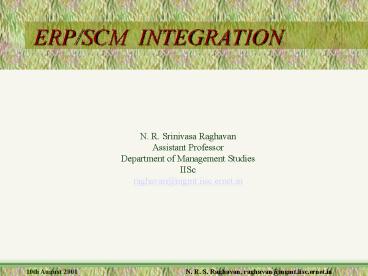ERP/SCM INTEGRATION PowerPoint PPT Presentation
Title: ERP/SCM INTEGRATION
1
ERP/SCM INTEGRATION
N. R. Srinivasa Raghavan Assistant
Professor Department of Management
Studies IISc raghavan_at_mgmt.iisc.ernet.in
2
The E-Quations
E-SRM E-SCM E-ERP E-CRM
E-SEM E-LOGISTICS
E-PDM
- E-SCM E-PROCUREMENT
- E-MANUFACTURING
E-PLANNING - E-DISTRIBUTION
3
Information Systems in SCM
Stgc Alliance formulation Devp of Core
Competence
Strategic Planing
VRP Schg
Invy.Control NPD SCN
Design FMS
Virtual/Vertical Integration
Decision OPT Analysis Tools
Fin. Mgmt.
Cust.Serv. Mmt. Cost/Asset Mgmt.
Productivity Mmt. Vendor Mgmt.
Quality Mmt.
Mgmt Control
ERP
ODP
Shipping CRM Inventory
Assignment Pricing Inventory
Payrolls etc.
4
Integration _at_ what levels?
- Transaction level
- Management control level
- Decision analysis level
- Strategic planning level
5
Need for Integration Strategic motivation
I
-
Quality costs
Quality issues
6
Need for Integration Operational motivation
Customers
Sudden 20 raise in retail demand
B/D of logistics operations
Distribution Centers
M/C 2010 is down. Will be up again in 3 days
Factory
Lockout forces prodn. to be shut
Supplier
7
Solutions due to ERP are myopic
- An ERP System would react by-
- Adapting the schedule of machine 2010 and
reschedule other manufacturing orders. - Send orders through EDI to the distribution
centre - Arrange for alternate fleet to route finished
goods. - Impact on total supply chain is ignored
8
S/W Modules covering the SCP
Long term
STRATEGIC NETWORK PLANNING
Medium term
Short term
9
Global SCN Formulation
- Maximize Sum of the global after tax discounted
yearly profits (,Rs,etc) - S.t., for every planning period
- Supplier's capacity
- Production capacity at plants and DC's
- Transportation capacity of channels
- Customer demand constraints, BOM
- Minimum profit for SBU's on a country basis
- Solution MILP Use ILOG/CPLEX/NEOS etc.
10
Global SCN Formulation Data requirements
- Average capacities available at various entities
(at any granularity desired eg.
Machine-Shopfloor-Factory) - Availability and utilization of logistics fleet
- Estimates/Forecasts of customer demand by region,
product etc - Average per unit costs incurred for various
resources - BOM
- All obtainable from OLTP systems
11
ATP Computations
- Provide promised dates for customers
- - influences leadtime on time delivery
- Generate fast reliable order promises (esp.
in E- business environment) - Helps in retaining customers increasing
market share - Complexity increases as
- of parts increase PLC decr. of
customers increaseflexible pricing
policiesdemand gets uncertain. - Should be based on status of ALL SCN facilities
12
Scheduling
- Generate detailed prodn./procurement/tptn
schedules for all - facilities over a rlatively short interval
of time. - Specify start end time of various
activities - Identify bottlenecks provide efficient
means of prompt - delivery of customer desired products
right place time - objectives
makespan. sum of
lateness/tardiness sum of flow times
sum of set up times
max.lateness/tardiness
13
Phases in Scheduling
- 1. Model building-ILP, queueing model, NLP
- 2. Extracting required data from ERP system- (set
up time,cycle time - m/c breakdown data, resource
requirements) - 3. Generating scenarios (input cases)
- 4. Iterative creation/adjustment of schedules
- 5. Approve a scenario
- 6. Executing the schedule via ERP system.
14
SCM Solutions i2 RHYTHM
- Source Make
Deliver Sales
Long term
Mid term
Short term
15
SCM Solutions J. D. Edward's
- Source Make
Deliver Sales
Long term
Mid term
Short term
16
SCM Solutions SAP's APO
- Source Make
Deliver Sales
Long term
Mid term
Short term
17
Integration Issues
- SCM solutions need to be integrated in existing
IT Systems
SCM cannot replace ERP.On the contrary, they
extend planning tasks
18
Integration with ERP
- ERP has transactional data
- SCM solution regularly has to talk to several
ERP/OLTP - systems of various SC entities.
- Two models required
- A. Integration model-(what)
- Defines - Which objects are exchanged
(eg.BOMs, routings, - inventory levels,
Customer Order, PO, etc) - - Their origin
- - Which planning tasks
performed on which system.
19
Integration with ERP (contd)
B. Data exhange model (how)
Specifies how the flow of data info between
systems is organized. Most
solutions provide a macro language to define
these models
An SCM solution should
Match data items from ERP system structure it
Provide Import/Export formats (eg.ASCII format
with fixed field size or csv files)
20
Data exchange model
Two types - Initial transfer
Incremental transfer
Master data (Long term changes, new facility, new
shifts, new suppliers, etc.)
Transactional data (for implementation of plans)
21
Data exchange model (contd.)
- ERP
SCM
BOM, Inv.levels, routing,..
Initial tranfer
Model building
Model adjustment
Incremental tranfer
Master data
Transactional data
Planning data
Incremental tranfer
22
Integration with D/W
- ERP
D/W
Historical snap shots Decision support
purposes KDD/Data mining/OLAP
Real time data Transactional purposes
D/W are mainly used in demand planning Finding
patterns in demand using stats OLAP tools help
in fast and powerful reporting on data
23
Data warehouses and SCM
- Collect data from various companies
- Ensure consistency of data from disparate
transactional - systems
SCM
D/W
Model building
OLAP tools
Historical data
KDD data mining tools
Time series analysis
24
Classification of SCM integration techniches
Standard middleware pdt eg.CORBA
Standard Technology
Internal interfaces eg.SAP R/3, APO
Vendor specific middleware eg.i2 RhythmLink
Vendor specific technology
Open only for pdts of vendor
Open for other systems
25
SCM Solution Providers A Glance

